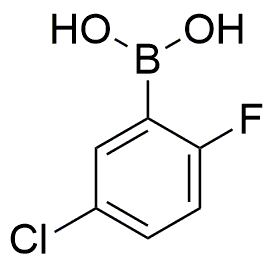5-Chloro-2-fluorophenylboronic acid is widely utilized in research focused on:
- Pharmaceutical Development: This compound plays a crucial role in synthesizing various pharmaceuticals, particularly in the development of targeted cancer therapies. Its ability to form stable complexes with biomolecules enhances drug efficacy.
- Organic Synthesis: It serves as a key building block in organic chemistry, allowing researchers to create complex molecules through Suzuki coupling reactions. This is particularly beneficial in the production of agrochemicals and fine chemicals.
- Material Science: The compound is used in the development of advanced materials, including polymers and nanomaterials, which can be applied in electronics and coatings due to their unique properties.
- Bioconjugation: It is utilized in bioconjugation techniques, enabling the attachment of biomolecules to surfaces or other molecules, which is essential in creating biosensors and diagnostic tools.
- Research in Catalysis: The compound is explored in catalytic processes, enhancing reaction rates and selectivity, which is vital for efficient chemical manufacturing and reducing waste in industrial processes.
General Information
Properties
Safety and Regulations
Applications
5-Chloro-2-fluorophenylboronic acid is widely utilized in research focused on:
- Pharmaceutical Development: This compound plays a crucial role in synthesizing various pharmaceuticals, particularly in the development of targeted cancer therapies. Its ability to form stable complexes with biomolecules enhances drug efficacy.
- Organic Synthesis: It serves as a key building block in organic chemistry, allowing researchers to create complex molecules through Suzuki coupling reactions. This is particularly beneficial in the production of agrochemicals and fine chemicals.
- Material Science: The compound is used in the development of advanced materials, including polymers and nanomaterials, which can be applied in electronics and coatings due to their unique properties.
- Bioconjugation: It is utilized in bioconjugation techniques, enabling the attachment of biomolecules to surfaces or other molecules, which is essential in creating biosensors and diagnostic tools.
- Research in Catalysis: The compound is explored in catalytic processes, enhancing reaction rates and selectivity, which is vital for efficient chemical manufacturing and reducing waste in industrial processes.
Documents
Safety Data Sheets (SDS)
The SDS provides comprehensive safety information on handling, storage, and disposal of the product.
Product Specification (PS)
The PS provides a comprehensive breakdown of the product’s properties, including chemical composition, physical state, purity, and storage requirements. It also details acceptable quality ranges and the product's intended applications.
Certificates of Analysis (COA)
Search for Certificates of Analysis (COA) by entering the products Lot Number. Lot and Batch Numbers can be found on a product’s label following the words ‘Lot’ or ‘Batch’.
*Catalog Number
*Lot Number
Certificates Of Origin (COO)
This COO confirms the country where the product was manufactured, and also details the materials and components used in it and whether it is derived from natural, synthetic, or other specific sources. This certificate may be required for customs, trade, and regulatory compliance.
*Catalog Number
*Lot Number
Safety Data Sheets (SDS)
The SDS provides comprehensive safety information on handling, storage, and disposal of the product.
DownloadProduct Specification (PS)
The PS provides a comprehensive breakdown of the product’s properties, including chemical composition, physical state, purity, and storage requirements. It also details acceptable quality ranges and the product's intended applications.
DownloadCertificates of Analysis (COA)
Search for Certificates of Analysis (COA) by entering the products Lot Number. Lot and Batch Numbers can be found on a product’s label following the words ‘Lot’ or ‘Batch’.
*Catalog Number
*Lot Number
Certificates Of Origin (COO)
This COO confirms the country where the product was manufactured, and also details the materials and components used in it and whether it is derived from natural, synthetic, or other specific sources. This certificate may be required for customs, trade, and regulatory compliance.


